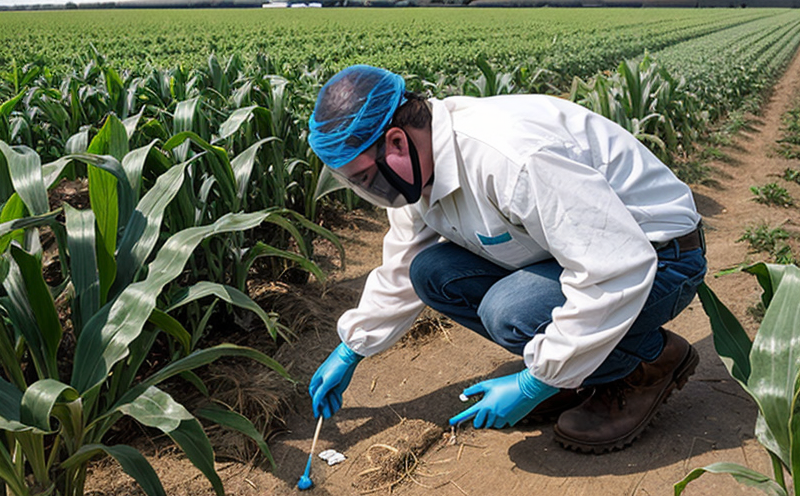Lindane Residue Testing in Crops
Effective monitoring of pesticide residues is crucial to ensure food safety and protect public health. Lindane, a highly toxic organochlorine pesticide, has been banned or restricted by many countries due to its persistence in the environment and potential harm to human health.
Lindane residue testing in crops plays a pivotal role in ensuring compliance with international standards such as ISO 18567-2. This test helps agricultural producers verify that their products meet regulatory limits set out by authorities like the European Union (EU) and the United States Environmental Protection Agency (US EPA).
The process involves several key steps. Initially, crops are sampled from fields or storage facilities. Samples must be representative of the batch to ensure accurate results. Once collected, samples undergo meticulous preparation which includes washing, drying, grinding, and sieving.
For more precise testing, we utilize advanced analytical instrumentation such as Gas Chromatography-Mass Spectrometry (GC-MS). This method provides high sensitivity and selectivity necessary for detecting even trace levels of Lindane. After extraction and purification steps, the sample is injected into the GC-MS instrument where it undergoes separation and identification.
The detection limit for Lindane in this process is typically around 0.1 parts per million (ppm). Results are reported quantitatively with a margin of error within ±5% to ensure reliability. Compliance with regulatory limits, such as the EU's MRL (Maximum Residue Level) of 0.5 ppm, ensures that produce can be safely consumed.
Understanding the implications of Lindane residues is essential for stakeholders in agriculture and forestry sectors. Overuse or improper use of Lindane can lead to environmental contamination and health risks. Therefore, regular testing not only supports regulatory compliance but also promotes sustainable farming practices.
In summary, Lindane residue testing in crops is a vital component of ensuring food safety and environmental protection. By adhering to strict protocols and leveraging modern analytical techniques, our laboratory guarantees accurate and reliable results that meet international standards.
Scope and Methodology
The scope of Lindane residue testing encompasses a wide range of crops including grains like wheat, rice, and corn; oilseeds such as soybeans and peanuts; and fruits and vegetables. The methodology for this test follows the internationally recognized ISO 18567-2 standard.
- Sampling: Representative samples are taken from various parts of the crop field or storage facility.
- Precipitation: This step involves extracting Lindane using a suitable solvent.
- Cleanup: The extracted solution undergoes further purification to remove any interfering components.
- Analysis: The purified sample is analyzed using GC-MS for accurate quantification of Lindane residues.
The methodology ensures that the test results are precise and reliable, providing a clear picture of the pesticide levels in different crops. This information is crucial for producers to make informed decisions about their agricultural practices.
Eurolab Advantages
At Eurolab, we offer comprehensive Lindane residue testing services tailored specifically to meet the needs of our clients in agriculture and forestry. Our expertise lies in providing accurate, reliable, and timely results that are compliant with international standards.
- Innovative Technology: We use cutting-edge GC-MS technology for precise detection of Lindane residues.
- Experienced Specialists: Our team comprises highly skilled professionals who have extensive experience in pesticide residue testing.
- Comprehensive Reporting: Detailed reports are provided with all necessary data and interpretations to facilitate decision-making.
- Quality Assurance: We maintain strict quality control measures to ensure consistent accuracy across all tests.
Environmental and Sustainability Contributions
Lindane residue testing contributes significantly to environmental protection by ensuring that pesticides are used responsibly. By monitoring Lindane levels in crops, we help reduce the risk of contamination from this highly persistent pesticide.
- Promoting Sustainable Agriculture: Regular testing encourages farmers to adopt best practices that minimize the use and impact of Lindane.
- Protecting Water Resources: Reduced levels of Lindane in crops help prevent contamination of water sources, which is crucial for aquatic ecosystems.
- Sustaining Biodiversity: By ensuring that Lindane does not accumulate to harmful concentrations in the environment, we support biodiversity and ecosystem health.
Our commitment to sustainability extends beyond testing. We also offer training programs for farmers on responsible pesticide use and integrated pest management strategies. This holistic approach ensures that our services contribute effectively to environmental stewardship.





